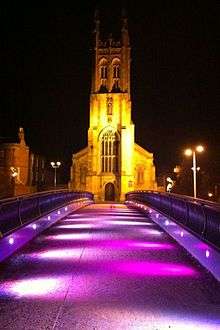Saint Alkmund's Way Footbridge
| Saint Alkmunds Way Footbridge | |
|---|---|
 Saint Alkmunds Way Footbridge | |
| Coordinates | 52°55′37″N 1°28′44″W / 52.927°N 1.479°WCoordinates: 52°55′37″N 1°28′44″W / 52.927°N 1.479°W |
| Carries | Pedestrians & Cycles |
| Crosses | Saint Alkmunds Way (A601) |
| Locale | Derbyshire |
| Maintained by | Derby City Council |
| Characteristics | |
| Total length | 45 Metres |
| Width | 5 Metres |
| Height | 6.2 Metres |
| History | |
| Designer | Derby City Council. Clive Russel, Mohammed Haque, Phill Massey & Peter Dobson Public Art by:Dennis O’Connor & T4 |
| Opened | October 2007 |
| Statistics | |
| Daily traffic | 1,500 (2009 estimates) |
| Toll | Free |
Saint Alkmund's Way Footbridge is a replacement cycle and footbridge in Derby, England over the A601 (St. Alkmund's Way). The 2007 design includes sculptures of silk bobbins at its entrance and exit that are inspired by the nearby Silk Mill museum.
Description
In 2007 Derby City Council demolished and rebuilt the footbridge over St Alkmund’s Way to link the city centre with St Mary’s Church.[1] It is one of Derby’s most-seen bridges and the council worked with Public Artist Denis O'conner and T4 sustainability to design more aesthetically pleasing solution, viewed by an estimated 1,500 pedestrian and 70,000 motorists every day.[1]
Funding came from Derby City Council, the Department for Transport and the Derby and Derbyshire Economic Partnership.[1] The final cost was £1.3 million,[2] and the council's contribution was part of a £2 million overspend on highways in 2007.[3]
Derby Councillor Chris Wynn, cabinet member for planning and highways, said "The design with the bobbins and billowing silk idea will tie in well with the Silk Mill and I think this will be very exciting when it comes to fruition."[4] It was decided in 2009 to close the Silk Mill museum for an unspecified period.[5]

The bridge took just fourteen weeks to construct, the new bridge is wider than its predecessor and is designed to take both cycle and pedestrian traffic.[6] Although a shortage of steel meant that some of the design features and the lighting were not installed when it was nominally complete in October 2007.[2]
The early start was possible because the council had given the go-ahead to purchase steel before funding was confirmed in March 2007.[4]
The bridge design was inspired by the traditional silk route through the city and has given inspiration to the Cathedral Green Footbridge, with its iconic needle-shaped mast,[7] as they both draw inspiration from the Silk Mill and use its heritage as inspiration.
References
- 1 2 3 Hodgekiss, Anna (24 July 2007). "Derby lands £137.9B footbridge". Propertweek.com. Retrieved 3 January 2011.
- 1 2 "Bridge to open despite steel woes". BBC News. 26 October 2007. Retrieved 3 January 2011.
- ↑ "Council explains road overspend". BBC News. 12 April 2007. Retrieved 3 January 2011.
- 1 2 Derby Evening Telegraph, 7 April 2007
- ↑ Report of the Strategic Director of Neighbourhoods 26 October 2010, accessed 4 January 2011
- 1 2 "Bridging Past and Future" (PDF). Derby.gov.uk. p. 3. Retrieved 5 January 2011.
- ↑ Prime Minister's Award, 2009, accessed January 2011